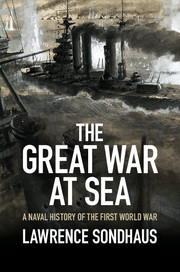Book contents
- Frontmatter
- Contents
- List of figures
- List of maps
- Acknowledgments
- Introduction
- 1 Ambition, ideology, and arms races
- 2 Preparing for war
- 3 Global prelude
- 4 European waters, 1914–15
- 5 Submarine warfare: The great experiment, 1915
- 6 Combined operations, 1915
- 7 The year of Jutland: Germany’s fleet sorties, 1916
- 8 Submarine warfare: The great gamble, 1917–18
- 9 War and revolution, 1917
- 10 Final operations
- Conclusion: Peace and naval disarmament
- Bibliography
- Index
- References
5 - Submarine warfare: The great experiment, 1915
Published online by Cambridge University Press: 05 August 2014
- Frontmatter
- Contents
- List of figures
- List of maps
- Acknowledgments
- Introduction
- 1 Ambition, ideology, and arms races
- 2 Preparing for war
- 3 Global prelude
- 4 European waters, 1914–15
- 5 Submarine warfare: The great experiment, 1915
- 6 Combined operations, 1915
- 7 The year of Jutland: Germany’s fleet sorties, 1916
- 8 Submarine warfare: The great gamble, 1917–18
- 9 War and revolution, 1917
- 10 Final operations
- Conclusion: Peace and naval disarmament
- Bibliography
- Index
- References
Summary
“Firing from a submarine is extraordinarily difficult,” Tirpitz reminded Admiral Pohl, chief of the Admiralstab, adding that this was especially so if the target of the torpedo “maintains a higher speed and changes course frequently.” The admonition came in a letter dated October 1, 1914, nine days after U 9’s spectacular sinking of the British armored cruisers Aboukir, Hogue, and Cressy off the Dutch coast made the submarine’s commander, Kapitänleutnant Otto Weddigen, the German navy’s first war hero. Tirpitz downplayed the success by pointing out to Pohl that the Aboukir was steaming “at ten knots,” and furthermore, “the Hogue and Cressy were stationary when attacked,” making them very easy to sink. He conceded that, going into the war, the offensive potential of the submarine had been “underestimated, but…it is now exaggerated as a result of the success of U 9.” These remarks came in a preamble to a lengthy defense of the battle fleet Tirpitz had worked so hard to build, a legacy that now seemed threatened by the unexpected effectiveness of the navy’s smallest vessels, which the Germans (like everyone else) had developed before the war for short-range defensive purposes. But when the focus shifted to attacking merchant vessels, Tirpitz’s position on U-boats began to change. After U 17 torpedoed and sank the British merchantman Glitra off the Norwegian coast on October 20, German submarine commanders gradually became more aggressive in their targeting of unarmed ships. Having initially respected norms devised for commerce raiders – which called for crews to be allowed to abandon ship, and obligated the attacker to provide for their safety – U-boats on occasion began to sink their targets without warning, or leave survivors to fend for themselves.
- Type
- Chapter
- Information
- The Great War at SeaA Naval History of the First World War, pp. 136 - 170Publisher: Cambridge University PressPrint publication year: 2014



